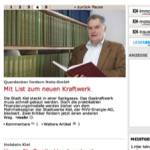Süddeutsche Zeitung German Newspaper, published in Munich, is the largest German national subscription daily newspaper.
On 6 October 1945,five months after the end of World War II in Germany, the SZ was the first newspaper to receive a license from the U.S. military administration of Bavaria. The first issue was published the same evening. The first article begins with:
For the first time since the collapse of the brown rule of terror, a newspaper run by Germans is published in Munich. It is limited by the political necessities of our days, but it is not bound by censorship, nor gagged by constraints of conscience.
A reversal in ad sales in the early 2000s was so severe that it brought the paper to the brink of bankruptcy in October 2002. The Süddeutsche survived through a 150 million euro investment by a new shareholder, a regional newspaper chain called Südwestdeutsche Medien. Over a period of three years, the newspaper underwent a reduction in his staff to 307, from 425, the closing of a regional edition in Düsseldorf, and the scrapping of a section devoted to news from Berlin.
In spring 2004, SZ launched the Süddeutsche Bibliothek. Each week, one out of 50 famous novels of the 20th century was made available in hardcover at certain newsstands and in book shops. Later a series of 50 influential movies on DVD followed. In late 2004 the daily also launched a popular science magazine, SZ Wissen.In late 2005 a series of children’s books continued this branch of special editions.
The title, often abbreviated SZ, translates as “South German Newspaper” (The literal translation for the German word “Zeitung” is “tiding”). It is read throughout Germany by 1.1 million readers daily and boasts a relatively high circulation abroad. The editorial stance of the newspaper is liberal and generally of centre-left,leading some to joke that the SZ is the only opposition in the state of Bavaria, which has been governed by the conservative Christian Social Union of Bavaria almost continuously since 1949.






